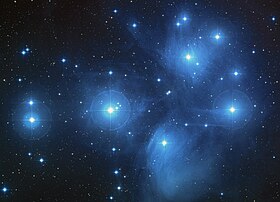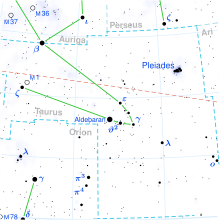Pleione (star)
| Observation data Epoch J2000 Equinox J2000 | |
|---|---|
| Constellation | Taurus |
| Right ascension | 03h 49m 11.2166s[1] |
| Declination | 24° 08′ 12.157″[1] |
| Apparent magnitude (V) | 4.77 - 5.50[2] |
| Characteristics | |
| Evolutionary stage | Main sequence |
| Spectral type | B8Vne[3] |
| B−V color index | −0.08[4] |
| Variable type | γ Cas[2] |
| Absolute magnitude (MV) | −0.347[6] |
| Details | |
Myr | |
HR 1180, SAO 76229 | |
| Database references | |
| SIMBAD | data |
Pleione
The brighter star of the Pleione binary pair, component A, is a hot
Nomenclature
28 Tauri is the star's
Visibility
With an
Pleione is classified as a
There has been significant debate as to the star's actual distance from
Properties
In 1942
Be star

Pleione is a classical
Be Stars are fast rotators (>200 km/s), causing them to be highly oblate, with a substantial stellar wind and high mass loss rate.[22] Pleione's rotational velocity of 329 km/s is considerably faster than the 251 km/s of Achernar, a prototypical Be star.[9][27] Pleione revolves on its axis once every 11.8 hours, compared to 48.4 hours for Achernar.[note 4] For comparison, the Sun takes 25.3 days to rotate. Pleione is spinning so fast that it is close to the estimated breakup velocity for a B8V star of about 370–390 km/s, which is why it is losing so much mass.[28]

Pleione is unusual because it alternates between three different phases: 1) normal

As a result of such dynamics, Pleione exhibits prominent long-term
These phase changes are ascribed to the evolution of a decretion disc that formed in 1972.[30] Polarimetric observations show the intrinsic polarization angle has changed, indicating a change in orientation of the disc axis.[32] Because Pleione has a stellar companion with a close orbit, the shift in the polarization angle has been attributed to the companion causing a precession (wobble) of the disk, with a precession period of roughly 81 years.[32]
Photometric and spectroscopic observations from 2005 to 2007 indicated that a new disc had formed around the equator – producing a two discs at different inclination angles (60° and 30°).[30][32] Such a misaligned double-disc structure had not been observed around other Be stars.[30][32]
Star system
Pleione is known to be a
Ethnological influences
Mythology
Pleione was an
Etymology
When names were assigned to the stars in the Pleiades cluster, the bright pair of stars in the East of the cluster were named Atlas and Pleione, while the seven other bright stars were named after the
There is some diversity of opinion as to the origin of the names Pleione and Pleiades. There are three possible derivations of note. Foremost is that both names come from the Greek word πλεῖν, (pr. ple'-ō), meaning "to sail".[40][41] This is particularly plausible given that ancient Greece was a seafaring culture and because of Pleione's mythical status as an Oceanid nymph. Pleione, as a result, is sometimes referred to as the "sailing queen" while her daughters the "sailing ones". Also, the appearance of these stars coincided with the sailing season in antiquity; sailors were well advised to set sail only when the Pleiades were visible at night, lest they meet with misfortune.[39]
Another derivation of the name is the Greek word Πλειόνη[37] (pr. plêionê), meaning "more", "plenty", or "full"—a lexeme with many English derivatives like pleiotropy, pleomorphism, pleonasm, pleonexia, plethora and Pliocene. This meaning also coincides with the biblical Kīmāh and the Arabic word for the Pleiades — Al Thurayya.[40] In fact, Pleione may have been numbered amongst the Epimelides (nymphs of meadows and pastures) and presided over the multiplication of the animals, as her name means "to increase in number".[42]
Finally, the last comes from
Modern legacy
In the best-selling 1955
Given its mythical connection with
See also
- Lists of stars in the constellation Taurus
- Class B Stars
- Be stars
- Shell star
- Circumstellar disk
Notes
- ^ Pronounced /ˈplaɪəniː/ PLY-anee or /ˈpliːəniː/ PLEE-ənee
- ^ The brightness ratio of Atlas versus Pleione is derived from the formula for apparent magnitude and is based on their respective visual magnitudes: Atlas () at 3.62 and Pleione () at 5.05. Therefore:
- volumes. It is assumed that the volume of each star is reasonably approximated by the formula for a sphere:
- VA ≈ 4⁄3π × 103 ≈ 4,188.79 VSun
- VP ≈ 4⁄3π × 3.23 ≈ 137.26 VSun
- ^ The time it takes for Achernar (TA) and Pleione (TP) to rotate on its own axis is determined by taking the star's radius in solar units, multiplying by the Sun's radius in kilometers, then calculating the star's circumference at the equator and dividing by its speed of rotation per hour. Therefore:
- TA = 10 R☉ × 696,000 km × 2 × π ÷ 251 km/s ÷ 3,600 ≈ 48.4 hrs
- TP = 3.2 R☉ × 696,000 km × 2 × π ÷ 329 km/s ÷ 3,600 ≈ 11.8 hrs
References
- ^ .
- ^ Bibcode:2009yCat....102025S.
- Bibcode:2008PZP.....8....6T.
- ^
Nicolet, B. (1978). "Catalogue of homogeneous data in the UBV photoelectric photometric system". Bibcode:1978A&AS...34....1N.
- S2CID 119231169.
- ^ .
- ^ S2CID 166227927.
- S2CID 73594365.
- ^ hdl:11336/37946.
- S2CID 14116473.
- ^ "IAU Working Group on Star Names (WGSN)". Retrieved 22 May 2016.
- ^ "Bulletin of the IAU Working Group on Star Names, No. 1" (PDF). Retrieved 28 July 2016.
- ^ "IAU Catalog of Star Names". Retrieved 28 July 2016.
- ^ Getsova, I.; et al. (2002). "All About The Pleiades". Catch a Star 2002. European Southern Observatory. Archived from the original on 2020-10-27. Retrieved 2010-09-15.
- ^
Bakich, M. E. (22 April 2009). "See Mercury, the Moon, and the Pleiades together in the night sky". Astronomy. Retrieved 2010-09-14.
Don't miss a stunning sight around 9 P.M. local daylight time April 26 when a crescent Moon joins Mercury and the Pleiades in the deepening twilight.
- ^ a b
For an in-depth discussion of S2CID 16420237.
- ^
Allen, J.; Boyd, P. (15 April 1997). "Finding Stellar Distances". Ask an Astrophysicist. NASA. Retrieved 2010-09-14.
A straightforward summary of the different methods used by astronomers to measure stellar distances.
- ^
Perryman, M. A. C.; et al. (1997). "The Hipparcos Catalogue". masyielding a distance of about 119 ± 1.0pc or 388 ± 3.2ly
- ^ a b Weaver, D.; Soderblom, D. (1 June 2004). "Hubble Refines Distance to Pleiades Star Cluster". Hubblesite Newscenter. Retrieved 2010-09-13.
- ^
Struve, O. (1943). "The Story of Pleione". Bibcode:1943PA.....51..233S.
- ^ "Classical Be Stars". Research in Astronomy & Astrophysics at Lehigh. Lehigh University. Retrieved 2010-09-16.
- ^ a b Stee, P. "What is a Be star?". Hot and Active Stars Research. Retrieved 2010-06-20.
- ^ Plait, P. (5 August 2009). "To B[e] or not to B[e]". Bad Astronomy. Archived from the original on 2010-07-11. Retrieved 2010-09-20.
- ^
Porter, J. M.; Rivinius, T. (2003). "Classical Be Stars". doi:10.1086/378307.
- ^ a b "Glasgow astronomers explain hot star disks". SpaceRef. 1 November 2002. Retrieved 2010-06-20.[permanent dead link]
- ^ Thizy, O. "Be Stars". Shelyak Instruments. Archived from the original on 2011-09-27. Retrieved 2010-06-20.
- ^
"HR 20472". Bright Star Catalogue, 5th Revised Ed. (Hoffleit+, 1991). Centre de Données astronomiques de Strasbourg. Retrieved 2010-06-20.
- ^ a b
Hirata, Ryuko (1995). "Interpretation of the Long-Term Variation in Late-Type Active Be Stars". Bibcode:1995PASJ...47..195H.
- ^ Getsova, I.; et al. (20 September 2006). "To Be or Not to Be: Is It All About Spinning?" (Press release). European Southern Observatory. Retrieved 2010-09-16.
- ^ a b c d e f g Tanaka, K.; et al. (2007). "Dramatic Spectral and Photometric Changes of Pleione (28 Tau) between 2005 November and 2007 April" (PDF). . Retrieved 2010-06-13.
- . Retrieved 27 March 2022.
- ^ a b c d
Hirata, R. (2007). "Disk Precession in Pleione". Bibcode:2007ASPC..361..267H.
- ^
McAlister, H. A.; et al. (1989). "ICCD speckle observations of binary stars. IV – Measurements during 1986–1988 from the Kitt Peak 4 M telescope". doi:10.1086/115001.
- ^ Katahira, Jun-Ichi; et al. (1996). "Period Analysis of the Radial Velocity in PLEIONE". .
- ^ Mason, B. D.; et al. (1996). "Pleione". Alcyone (Star Information Tool). Retrieved 2010-09-21.
- ^
Andrews, M. (2004). The Seven Sisters of the Pleiades – Stories from around the world. ISBN 1-876756-45-4. Retrieved 2010-10-07.
- ^ a b Smith, W. (1873). "Plei'one". A dictionary of Greek and Roman biography and mythology. John Murray. Retrieved 2010-06-17.
- ^ Athena, A. (8 July 2010). "Nymphs". Women in Greek Myths. Retrieved 2010-10-07.
- ^ a b Apollodorus (1921). "Book 3, Chapter 10, Section 1". The Library. Translated by Frazer, J. G. Retrieved 2010-06-17.
- ^ a b c Allen, R. H. (1963). "Star Names: Their Lore and Meaning". Dover Publications. p. 408. Retrieved 2010-06-11.
- National Astronomy and Ionosphere Center. Archived from the originalon 2021-03-26. Retrieved 2010-06-18.
- ^ Atsma, A. J. (8 March 2010). "Pleione". Theoi Greek Mythology. Retrieved 2010-06-14.
- ^
ISBN 0-585-30250-2. Retrieved 2010-10-13.
- ^ Barnett, L. (1955). The World We Live In. Simon & Schuster. p. 284.
- ^ "Team Pleione". Marblehead International One Design Class. Retrieved 2010-10-07.[permanent dead link]
- ^ Taylor, J. (19 March 2009). "Fast Boats in the 'Spirit of Tradition'". Jim Taylor Yacht Designs. Archived from the original on 17 February 2010. Retrieved 2010-10-07.
- ^ Chami, C. (9 January 2008). "Paul Andreu – The Oriental Arts Centre in Shanghai". Archinnovations. Archived from the original on 2012-03-07. Retrieved 2010-10-07.
- ^ Hundred Eight Stars at Discogs
External links
- Jim Kaler's Stars, University of Illinois: PLEIONE (28 Tauri)
- Philippe Stee's in-depth information on: Hot and Active Stars Research
- Olivier Thizy's in-depth information on: Be Stars
- High-resolution LRGB image based on 4 hrs total exposure: M45 – Pleiades Open Cluster
- APOD Pictures:
- Orion, the giant huntsman, in pursuit of the Pleiades
- Himalayan Skyscape
- Pleiades and the Milky Way
- Pleiades and the Interstellar Medium





